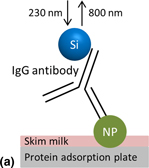Crossref Citations
This article has been cited by the following publications. This list is generated based on data provided by
Crossref.
Inoue, Asuka
Sugimoto, Hiroshi
Sugimoto, Yozo
Akamatsu, Kensuke
Hubalek Kalbacova, Marie
Ogino, Chiaki
and
Fujii, Minoru
2020.
Stable near-infrared photoluminescence from silicon quantum dot–bovine serum albumin composites.
MRS Communications,
Vol. 10,
Issue. 4,
p.
680.
Robidillo, Christopher Jay T.
and
Veinot, Jonathan G. C.
2020.
Functional Bio-inorganic Hybrids from Silicon Quantum Dots and Biological Molecules.
ACS Applied Materials & Interfaces,
Vol. 12,
Issue. 47,
p.
52251.
Fujii, Minoru
Fujii, Riku
Takada, Miho
and
Sugimoto, Hiroshi
2020.
Silicon Quantum Dot Supraparticles for Fluorescence Bioimaging.
ACS Applied Nano Materials,
Vol. 3,
Issue. 6,
p.
6099.
Fujii, Minoru
Minami, Akiko
and
Sugimoto, Hiroshi
2020.
Precise size separation of water-soluble red-to-near-infrared-luminescent silicon quantum dots by gel electrophoresis.
Nanoscale,
Vol. 12,
Issue. 16,
p.
9266.
Martín-Gracia, Beatriz
Martín-Barreiro, Alba
Cuestas-Ayllón, Carlos
Grazú, Valeria
Line, Aija
Llorente, Alicia
M. de la Fuente, Jesús
and
Moros, María
2020.
Nanoparticle-based biosensors for detection of extracellular vesicles in liquid biopsies.
Journal of Materials Chemistry B,
Vol. 8,
Issue. 31,
p.
6710.
Turanský, R.
Brndiar, J.
Pershin, A.
Gali, Á.
Sugimoto, H.
Fujii, M.
and
Štich, I.
2021.
Structure and Properties of Heavily B and P Codoped Amorphous Silicon Quantum Dots.
The Journal of Physical Chemistry C,
Vol. 125,
Issue. 42,
p.
23267.
Fujii, Minoru
Sugimoto, Hiroshi
and
Kano, Shinya
2022.
Colloidal solution of boron and phosphorus codoped silicon quantum dots—from material development to applications.
Japanese Journal of Applied Physics,
Vol. 61,
Issue. SA,
p.
SA0807.
Pirzada, Muqsit
and
Altintas, Zeynep
2022.
Nanomaterials for virus sensing and tracking.
Chemical Society Reviews,
Vol. 51,
Issue. 14,
p.
5805.
Yemets, Alla
Plokhovska, Svitlana
Pushkarova, Nadia
and
Blume, Yaroslav
2022.
Quantum Dot-Antibody Conjugates for Immunofluorescence Studies of Biomolecules and Subcellular Structures.
Journal of Fluorescence,
Vol. 32,
Issue. 5,
p.
1713.
Sun, Di
Wu, Steven
Martin, Jeremy P.
Tayutivutikul, Kirati
Du, Guodong
Combs, Colin
Darland, Diane C.
and
Zhao, Julia Xiaojun
2023.
Streamlined synthesis of potential dual-emissive fluorescent silicon quantum dots (SiQDs) for cell imaging.
RSC Advances,
Vol. 13,
Issue. 38,
p.
26392.
Zhang, Yanan
Cai, Ning
and
Chan, Vincent
2023.
Recent Advances in Silicon Quantum Dot-Based Fluorescent Biosensors.
Biosensors,
Vol. 13,
Issue. 3,
p.
311.
Wegner, K. David
and
Hildebrandt, Niko
2024.
Near infrared quantum dots for biosensing and bioimaging.
TrAC Trends in Analytical Chemistry,
Vol. 180,
Issue. ,
p.
117922.
Saurabh, Umrao
Abhisek, Dwivedy
and
Xing, Wang
2025.
Nano-Engineering at Functional Interfaces for Multi-Disciplinary Applications.
p.
445.


